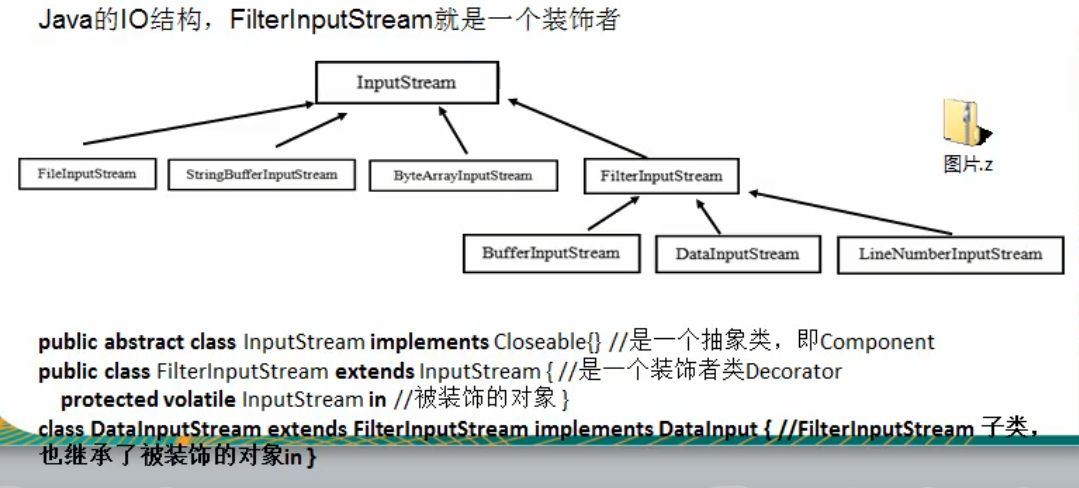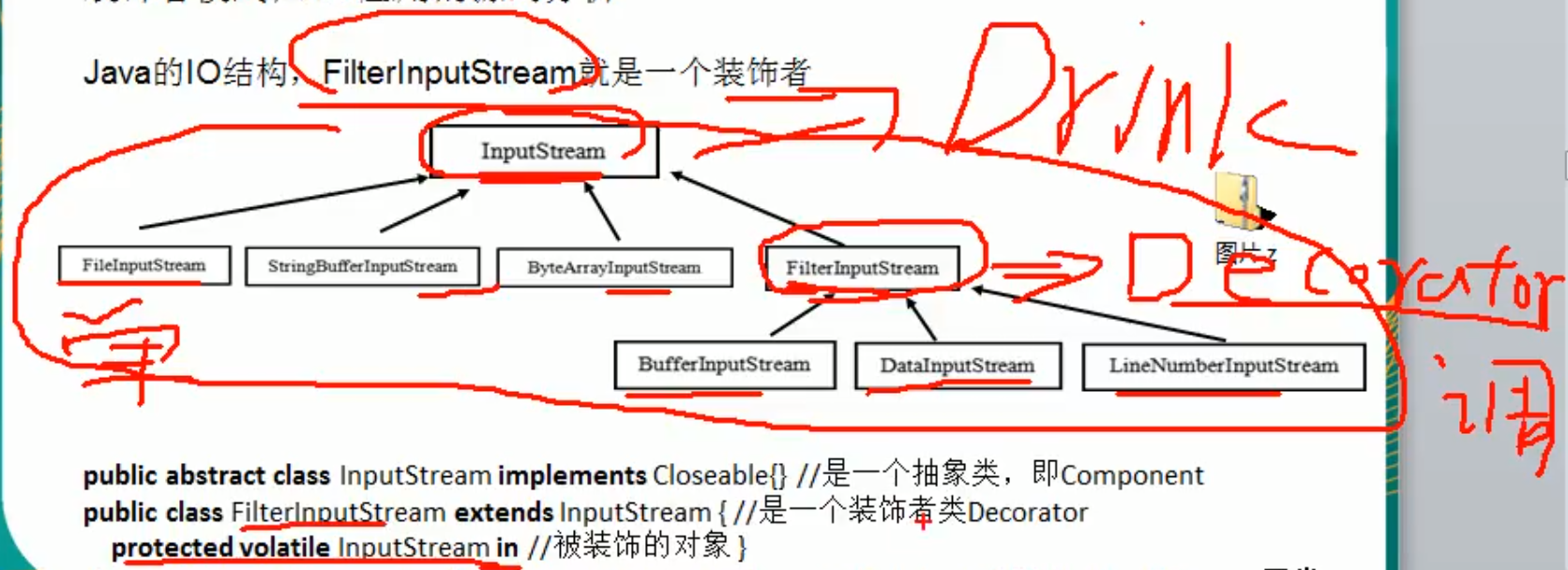装死者模式在JDK应用的源码分析
直接上代码
package com.atguigu.jdk;
import java.io.DataInputStream;
import java.io.FileInputStream;
public class Decorator {
public static void main(String[] args) throws Exception{
DataInputStream dis = new DataInputStream(
new FileInputStream("E:\\Projects\\IdeaProjects\\design_pattern\\out\\demo.txt")
);
/*
demo.txt 文件内容:
o
* */
System.out.println(dis.read());
dis.close();
/*
111
* */
}
}
/**
* A <code>FileInputStream</code> obtains input bytes
* from a file in a file system. What files
* are available depends on the host environment.
*
* <p><code>FileInputStream</code> is meant for reading streams of raw bytes
* such as image data. For reading streams of characters, consider using
* <code>FileReader</code>.
*
* @author Arthur van Hoff
* @see java.io.File
* @see java.io.FileDescriptor
* @see java.io.FileOutputStream
* @see java.nio.file.Files#newInputStream
* @since JDK1.0
*/
public
class FileInputStream extends InputStream
{
/* File Descriptor - handle to the open file */
private final FileDescriptor fd;
/**
* The path of the referenced file
* (null if the stream is created with a file descriptor)
*/
private final String path;
private FileChannel channel = null;
private final Object closeLock = new Object();
private volatile boolean closed = false;
InputStream是一个抽象的
/**
* This abstract class is the superclass of all classes representing
* an input stream of bytes.
*
* <p> Applications that need to define a subclass of <code>InputStream</code>
* must always provide a method that returns the next byte of input.
*
* @author Arthur van Hoff
* @see java.io.BufferedInputStream
* @see java.io.ByteArrayInputStream
* @see java.io.DataInputStream
* @see java.io.FilterInputStream
* @see java.io.InputStream#read()
* @see java.io.OutputStream
* @see java.io.PushbackInputStream
* @since JDK1.0
*/
public abstract class InputStream implements Closeable {
// MAX_SKIP_BUFFER_SIZE is used to determine the maximum buffer size to
// use when skipping.
private static final int MAX_SKIP_BUFFER_SIZE = 2048;
/**
* Reads the next byte of data from the input stream. The value byte is
* returned as an <code>int</code> in the range <code>0</code> to
* <code>255</code>. If no byte is available because the end of the stream
* has been reached, the value <code>-1</code> is returned. This method
* blocks until input data is available, the end of the stream is detected,
* or an exception is thrown.
*
* <p> A subclass must provide an implementation of this method.
*
* @return the next byte of data, or <code>-1</code> if the end of the
* stream is reached.
* @exception IOException if an I/O error occurs.
*/
public abstract int read() throws IOException;
/**
* A <code>FilterInputStream</code> contains
* some other input stream, which it uses as
* its basic source of data, possibly transforming
* the data along the way or providing additional
* functionality. The class <code>FilterInputStream</code>
* itself simply overrides all methods of
* <code>InputStream</code> with versions that
* pass all requests to the contained input
* stream. Subclasses of <code>FilterInputStream</code>
* may further override some of these methods
* and may also provide additional methods
* and fields.
*
* @author Jonathan Payne
* @since JDK1.0
*/
public
class FilterInputStream extends InputStream {
/**
* The input stream to be filtered.
*/
protected volatile InputStream in;
/**
* Creates a <code>FilterInputStream</code>
* by assigning the argument <code>in</code>
* to the field <code>this.in</code> so as
* to remember it for later use.
*
* @param in the underlying input stream, or <code>null</code> if
* this instance is to be created without an underlying stream.
*/
敲黑板
package com.atguigu.jdk;
import java.io.DataInputStream;
import java.io.FileInputStream;
public class Decorator {
public static void main(String[] args) throws Exception{
// 说明
// 1. InputStream 是抽象类,类似我们前面的Drink
// 2. FileInputStream 是 InputStream 子类,类似我们前面的DeCaf, LongBlack
// 3. FilterInputStream 是 InputStream 子类: 类似我们其那面的 Decorator 修饰者
// 4. DataInputStream 是 FilterInputStream子类, 具体的修饰者,类似其那面的 Milk,Soy 等
// 5. FilterInputStream 类 有 protected volatile InputStream in; 即含被装饰者
// 6. 分析得出: 在jdk的IO体系中,就是使用装饰者模式
DataInputStream dis = new DataInputStream(
new FileInputStream("E:\\Projects\\IdeaProjects\\design_pattern\\out\\demo.txt")
);
System.out.println(dis.read());
dis.close();
}
}
一句话
装饰者模式: 动态的将新功能附加到对象上


